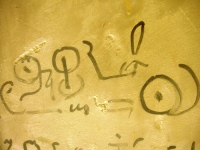- Introduction
- Further information

Hieratic inscription with information about the resealing of the tomb signed by the Superintendent of the Treasury Maya, 18th Dynasty, Reign of Horemheb; Valley of the King, Tomb of Thutmosis IV, KV 43
Hieratic, from the Greek hieratikòs - ‘priestly’, is a cursive tachygraphy of Hieroglyphics used on non-monumental objects, prevalently in administrative contexts.
It is a writing code which uses hieroglyphic signs, and simplifies them greatly, but all the while continuing to be a figurative system in every way. At least as old as Hieroglyphics, but unlike it, Hieratic is always written from right to left. Writing in columns was relegated from 1800 BC on to religious texts only. With the arrival of Demotic, Hieratic remained a priestly script only. Ancient, Middle and New Egyptian (the last was prevalently written in this script) were all written in Hieratic, and in some cases it had a punctuation system as well.
Go to the online resources.
Online resourcesPhoto Gallery
Examples of writing
Bibliography
Map of places
